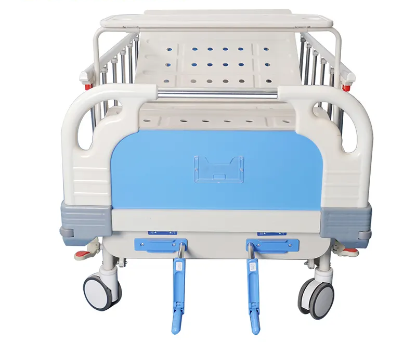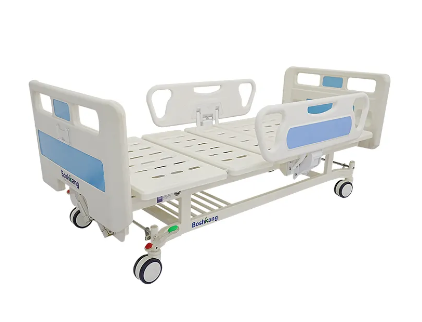Pag-unawa sa Komplikadong Merkado ng Mga Ekolohikal na Produkto sa Bahay
Ang industriya ng mga produktong ekolohikal, lalo na ang segment na nagtataglay ng mga Kama sa Ospital , ay nagpapakita ng isang kapanapanabik na pag-aaral sa pagkakaiba-iba ng presyo na kadalasang nagpapalito sa mga tagapamahala ng tahanan at mga mamimili. Ang mga presyo ng mga produktong ito ay maaaring magsimula sa ilang libong piso hanggang mahigit 40,000 piso bawat yunit, na nagpapakita ng isang kumplikadong ugnayan ng mga salik na nakakaapekto sa kanilang panghuling halaga. Ang malaking pagkakaiba-iba ng presyo ay hindi basta-basta lamang – ito ay bunga ng maraming mahahalagang elemento na nagtatakda sa parehong pag-andar ng produkto at sa kabuuang halaga nito sa pang-araw-araw na paggamit.
Kapag namuhunan ang mga pasilidad sa pangangalaga ng kalusugan sa mga Kama sa Ospital , hindi lamang sila bumibili ng muwebles; nakakakuha sila ng sopistikadong kagamitang medikal na gumaganap ng mahalagang papel sa pangangalaga sa pasyente, paggaling, at kahusayan ng kawani. Ang saklaw ng presyo ay sumasalamin sa lahat mula sa mga pangunahing manu-manong modelo hanggang sa mga napakakumplikadong elektronikong sistema na may pinagsamang mga kakayahan sa pagmamanman. Mahalaga ang pag-unawa sa mga pagkakaiba-iba upang makagawa ng matalinong mga desisyon sa pagbili habang tinitiyak ang optimal na pangangalaga sa pasyente.

Mga Pangunahing Tampok na Nagpapatakbo sa Kama sa ospital Mga gastos
Pagsasama ng Advanced na Teknolohiya
Isinasama ng modernong mga kama sa ospital ang sopistikadong teknolohiya na lubos na nakakaapekto sa kanilang mga puntos ng presyo. Kasama sa mga tampok ng teknolohiya ang mga elektronikong sistema ng pagpeposisyon, mga naka-embed na timbangan para sa pagmamanman sa timbang ng pasyente, at mga automated na mekanismo ng pagbawas ng presyon. Ang mga matalinong kama na may pinagsamang kakayahan sa pagmamanman ng mga palatandaang vital at koneksyon sa mga sistema ng impormasyon ng ospital ay kumakatawan sa mas mataas na dulo ng saklaw ng presyo, na kadalasang nangangailangan ng mas mataas na presyo dahil sa kanilang napapang advanced na pag-andar.
Ang pagsasama ng teknolohiya ng pressure mapping at smart sensors ay tumutulong sa pagpigil ng pressure ulcers at nagbibigay ng real-time na pagsubaybay sa posisyon ng pasyente. Ang mga pagsulong na ito sa teknolohiya, bagama't nagpapataas ng paunang presyo ng kama sa ospital, ay kadalasang nagreresulta sa pagtitipid sa gastos nang matagalang sa pamamagitan ng pagpapabuti sa kalalabasan ng pasyente at pagbawas sa pasanin ng kawani.
Kalidad at Kapanahunan ng Materiyal
Ang mga materyales na ginagamit sa paggawa ng kama sa ospital ay may malaking impluwensya sa kanilang presyo. Ang mga high-end na modelo ay gumagamit ng materyales na medikal na grado na sumusunod sa mahigpit na pamantayan ng pangangalagang pangkalusugan para sa kontrol ng impeksyon at tibay. Ang mga materyales na ito ay dapat makatiis sa madalas na paglilinis gamit ang matitinding disinfectant habang pinapanatili ang kanilang integridad at anyo. Ang mga premium na kama ay kadalasang may antimicrobial na surface at seamless na disenyo upang mapigilan ang paglago ng bakterya ngunit nagdaragdag din sa gastos ng produksyon.
Ang pagkakagawa ng frame, kung gumagamit man ng karaniwang bakal o advanced lightweight alloys, ay nakakaapekto sa parehong presyo at pag-andar. Ang de-kalidad na materyales ay nagsiguro ng mas matagal na habang-buhay at mas mahusay na kapasidad ng timbang, na nagpapahusay sa mas mataas na presyo ng kama sa ospital sa pamamagitan ng pagbawas sa dalas ng pagpapalit at mga gastos sa pagpapanatili.
Mga Espesyalisadong Tampok at Kanilang Epekto sa Gastos
Mga Mekanismo para sa Kaligtasan ng Pasyente
Ang mga tampok na pangkaligtasan ay nagsasaad ng isang mahalagang salik sa mga pagbabago ng presyo ng kama sa ospital. Ang mga advanced na modelo ay may kasamang sopistikadong sistema para maiwasan ang pagkahulog, awtomatikong mekanismo ng pagpepreno, at integrated na alarm sa paglabas ng kama. Ang mga tampok na ito ay hindi lamang nagpoprotekta sa mga pasyente kundi tumutulong din sa mga pasilidad sa pangangalagang pangkalusugan na matugunan ang mga kinakailangan sa regulasyon at mabawasan ang mga panganib sa pananagutan.
Ang mga disenyo ng side rail, kakayahan sa pag-angat ng taas, at mga mekanismo ng emergency release ay lahat nag-aambag sa kabuuang profile ng kaligtasan at, sa gayon din, sa presyo. Ang mga mahal na modelo ay kadalasang may kasamang maramihang redundant safety systems at fail-safes, na nagsisiguro ng maaasahang operasyon kahit sa mga critical na sitwasyon.
Pag-customize at Kakayahang Magbago
Ang kakayahan na i-customize at iangkop ang mga hospital bed para sa iba't ibang mga medikal na specialty ay may malaking epekto sa kanilang gastos. Ang mga specialty bed na idinisenyo para sa tiyak na mga departamento tulad ng intensive care, bariatric care, o pediatrics ay karaniwang may mas mataas na presyo dahil sa kanilang specialized na tampok at limitadong produksyon. Kadalasan, ang mga kama na ito ay nangangailangan ng natatanging mga elemento ng disenyo at karagdagang pagsubok upang matugunan ang tiyak na mga medikal na kinakailangan.
Ang mga modular na disenyo na nagpapahintulot ng mga susunod na pag-upgrade o pagbabago ay may posibilidad na magkaroon ng mas mataas na paunang presyo ng kama sa ospital ngunit nag-aalok ng mas mahusay na pangmatagalang halaga sa pamamagitan ng pagiging naaangkop sa mga nagbabagong pangangailangan sa pangangalaga ng kalusugan. Ang kakayahang magdagdag o baguhin ang mga tampok habang umuunlad ang mga pangangailangan sa medikal ay tumutulong na mapatunayan ang premium na presyo ng mga sariwang modelo.
Mga Salik sa Merkado na Nakakaapekto sa Pagpepresyo ng Kama sa Ospital
Lakihan ng Produksyon at Pamamahagi
Ang dami ng produksyon ay gumaganap ng mahalagang papel sa pagtukoy ng presyo ng kama sa ospital. Ang mga tagagawa na gumagawa ng mga standard na modelo sa malalaking dami ay nakakamit ng economies of scale, na nagreresulta sa mas mababang gastos bawat yunit. Gayunpaman, ang mga espesyal o pasadyang kama na ginawa sa mas maliit na dami ay karaniwang may mas mataas na presyo dahil sa mas mataas na gastos sa produksyon at mga espesyal na kinakailangan sa pagmamanufaktura.
Ang mga channel ng distribusyon at lokasyon sa heograpiya ay nakakaapekto rin sa presyo. Ang mga kama na nangangailangan ng espesyal na pag-aayos sa pagpapadala o mga ito ay nabibili sa mga merkado na may limitadong kompetisyon ay karaniwang may mas mataas na presyo. Ang internasyonal na pagpapadala, buwis sa customs, at lokal na regulasyon ay maaaring dagdagan pa ang panghuling gastos para sa mga pasilidad sa pangangalagang pangkalusugan.
Pag-uugnay ng Garantia at Serbisyo
Ang kumpletong saklaw ng warranty at kasunduan sa serbisyo ay may malaking epekto sa presyo ng kama sa ospital. Ang mga premium na modelo ay kadalasang kasama ang pinalawig na warranty, mga programa para sa preventive maintenance, at mabilis na oras ng tugon sa serbisyo. Ang mga karagdagang serbisyo ay nagbibigay ng halaga sa pamamagitan ng pagbawas ng downtime at mas matagal na buhay ng kagamitan ngunit nagdaragdag sa mas mataas na paunang gastos.
Ang kagampanan ng lokal na teknisyano sa serbisyo, imbentaryo ng mga parte, at imprastraktura ng suporta sa teknikal ay nakakaapekto pareho sa presyo ng pagbili at patuloy na gastos sa operasyon. Dapat isaalang-alang ng mga pasilidad sa pangangalagang pangkalusugan ang mga salik na ito kapag sinusuri ang kabuuang gastos ng pagmamay-ari sa iba't ibang puntos ng presyo.
Mga madalas itanong
Anong mga katangian ang pinakamalaking nakakaapekto sa presyo ng kama sa ospital?
Ang mga pinakamaimpluwensyang salik na nakakaapekto sa presyo ng kama sa ospital ay kinabibilangan ng mga elektronikong function, kalidad ng materyales, mga tampok na pangkaligtasan, at mga espesyalisadong medikal na kakayahan. Ang pagsasama ng mga abansadong teknolohiya, tulad ng automated na sistema ng pagpo-position at mga tampok sa pagmomonitor ng pasyente, ay karaniwang nagreresulta sa mas mataas na gastos.
Gaano katagal dapat magtagal ang isang kama sa ospital para maging makatwiran ang presyo nito?
Ang isang de-kalidad na kama sa ospital ay dapat magtagal ng 10-15 taon na may tamang pangangalaga. Ang mga modelong may mas mataas na presyo ay karaniwang nababayaran ang kanilang gastos sa pamamagitan ng mas matagal na tibay, mas kaunting pangangailangan sa pagpapanatili, at mas mahusay na pangmatagalang pagganap sa mga mapigil na kalikasan ng pangangalagang pangkalusugan.
Ang mga mahal na kama sa ospital ay palaging mas mabuti kaysa sa mga modelong may mababang presyo?
Hindi palagi. Nakadepende ito sa partikular na pangangailangan ng pasilidad, populasyon ng pasyente, at mga ugali sa paggamit. Bagama't may mas maraming tampok ang mga premium bed, maaaring sapat na para ilang mga pasilidad ang mga basic model. Ang susi ay ang pagtugma sa mga kakayahan ng kama sa aktwal na klinikal na pangangailangan at limitasyon sa badyet.
Paano mapapakinabangan ng mga pasilidad sa pangangalaga ng kalusugan ang kanilang pamumuhunan sa kama sa ospital?
Maari ng mapakinabangan ng mga pasilidad sa pangangalaga ng kalusugan ang kanilang pamumuhunan sa pamamagitan ng masusing pagsusuri sa kanilang partikular na pangangailangan, pag-iisip ng kabuuang gastos ng pagmamay-ari, at pagtatasa ng mga tuntunin ng warranty. Ang pagbili ng mga kama na may modular na disenyo at kakayahang i-upgrade ay kadalasang nagbibigay ng mas mahusay na halaga sa mahabang panahon kahit pa mas mataas ang paunang presyo ng kama sa ospital.
Talaan ng mga Nilalaman
- Pag-unawa sa Komplikadong Merkado ng Mga Ekolohikal na Produkto sa Bahay
- Mga Pangunahing Tampok na Nagpapatakbo sa Kama sa ospital Mga gastos
- Mga Espesyalisadong Tampok at Kanilang Epekto sa Gastos
- Mga Salik sa Merkado na Nakakaapekto sa Pagpepresyo ng Kama sa Ospital
-
Mga madalas itanong
- Anong mga katangian ang pinakamalaking nakakaapekto sa presyo ng kama sa ospital?
- Gaano katagal dapat magtagal ang isang kama sa ospital para maging makatwiran ang presyo nito?
- Ang mga mahal na kama sa ospital ay palaging mas mabuti kaysa sa mga modelong may mababang presyo?
- Paano mapapakinabangan ng mga pasilidad sa pangangalaga ng kalusugan ang kanilang pamumuhunan sa kama sa ospital?


